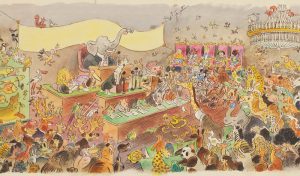Buddhism’s ultimate goal has always been to enable people to attain Buddhahood, or enlightenment. Early Buddhists believed, however, that achieving this highest state of life required carrying out incredible efforts over countless lifetimes.
The Lotus Sutra expounds a radically different perspective, teaching that rather than a destination to be reached sometime in the future, Buddhahood is already inherent in each person’s life. And it teaches that anyone can attain Buddhahood in this lifetime, in one’s present form.
But the question remained: How does one awaken to or manifest this innate Buddhahood?
In the sixth century, the Great Teacher T’ien-t’ai (538–97) emphasized the practice of “observing the mind” as a form of meditation focused on perceiving the true nature of the mind. But his system of meditation was extremely demanding and beyond the reach of anyone involved in the realities and responsibilities of daily life and society. Even among the monks who dedicated themselves fully to it, few were able to achieve its ultimate objective of enlightenment.
In the 13th century, Nichiren Daishonin pointed out that of the Ten Worlds, the nine worlds—except for the world of Buddhahood—are readily observable within the lives of people. The Buddha nature within us, however, is not so easy to see. Believing that one’s life or mind contains the Buddha nature is a requirement for one’s absolute happiness. Therefore, a practice that enables one to see and manifest this truth is essential.
Nichiren defined the principle of “embracing the Gohonzon is itself observing one’s mind” (Jpn juji soku kanjin) as follows: “The observation of the mind means to observe one’s own mind and to find the Ten Worlds within it” (“The Object of Devotion for Observing the Mind,” The Writings of Nichiren Daishonin, vol. 1, p. 356). He concludes that the true meaning of observing the mind and perceiving the Ten Worlds lies not just in observing but also in manifesting the world of Buddhahood within one’s life.
As such, the Daishonin teaches that we need a “clear mirror” (WND-1, 356) to carry out the practice of observing the mind, and he inscribed his life in the form of the Gohonzon for that purpose.
Here, the word embracing means “to accept and uphold,” which is the first of the “five practices” described in “The Teacher of the Law,” the 10th chapter of the Lotus Sutra. The five practices are to: 1) embrace (accept and uphold), 2) read, 3) recite, 4) expound (explain or preach) and 5) to transcribe (transmit to others or to propagate).
The Daishonin taught that, when it comes to the practice of the Mystic Law, to embrace—the first of the five practices—is the direct way to attain Buddhahood and includes all five practices.
Simply having the Gohonzon and chanting to it, though, does not fully constitute embracing the Gohonzon. If we face the clear mirror of the Gohonzon, for example, passively begging it for benefit or depending on it for protection, then no matter how much time we spend chanting before it, we ourselves will not manifest our inherent and limitless potential.
Rather, as SGI President Ikeda says, “By tirelessly polishing our own lives in the midst of our daily affairs, confident that we have in ourselves the same wonderful state of life as the Gohonzon embodies, our lives come to shine with good fortune and benefit” (May 2003 Living Buddhism, p. 24).
In “Letter to Gijo-bo,” which Nichiren wrote just one month after writing “The Object of Devotion for Observing the Mind,” the Daishonin explains in terms of his own life the principle of “embracing the Gohonzon is itself observing the mind.”
He refers to a passage from the verse section of “The Life Span of the Thus Come One,” the 16th chapter of the Lotus Sutra, which we recite every morning and evening. It reads: “Single-mindedly desiring to see the Buddha, not hesitating even if it costs them their lives” (The Lotus Sutra and Its Opening and Closing Sutras, p. 271).
Nichiren declares: “As a result of this passage, I have revealed the Buddhahood in my life” (WND-1, 389). And he says he has “attained the fruit of Buddhahood, the eternally inherent three bodies” (WND-1, 390). He urges his disciples to follow his lead and practice with the same spirit, saying, “This is what I mean when I emphatically urge you to give up even your body, and never begrudge even your life for the sake of the Lotus Sutra” (WND-1, 390).
Nichiren taught that chanting Nam-myoho-renge-kyo to the Gohonzon with the spirit of single-minded devotion constitutes “observing the mind.” Further, when one chants, the Buddha nature inherent in one’s life can be manifested. Ultimately then, the practice that he expounded for the sake of humanity is expressed in the principle that “embracing the Gohonzon is attaining Buddhahood.”
When we chant to the Gohonzon with the same single-minded determination as Nichiren and compassionately propagate his teachings, we can call forth the life state of Buddhahood inherent in the Gohonzon. In response, our own Buddha nature is awakened and manifested from within.
Ikeda Sensei describes this interaction between the external Gohonzon and the internal Buddha nature as a “responsive communion” between the Gohonzon and ourselves (see May 2003 Living Buddhism, p. 29).
This is the practice for attaining Buddhahood in one’s present form.
Sensei explains: “For this reason, when we chant Nam-myoho-renge-kyo while practicing for ourselves and others, with the Gohonzon of Nam-myoho-renge-kyo manifested by the Buddha as our clear mirror, and with deep confidence in the Gohonzon existing in our own lives, Myoho-renge-kyo within us resonates with the Myoho-renge-kyo outside us, and the world of Buddhahood emerges within us” (May 2003 Living Buddhism, p. 29).
In doing so, we reveal our true identity as that of a Buddha and begin to live based on a vow, enabling all people to awaken to this same inherent and irrefutable truth.
You are reading {{ meterCount }} of {{ meterMax }} free premium articles





